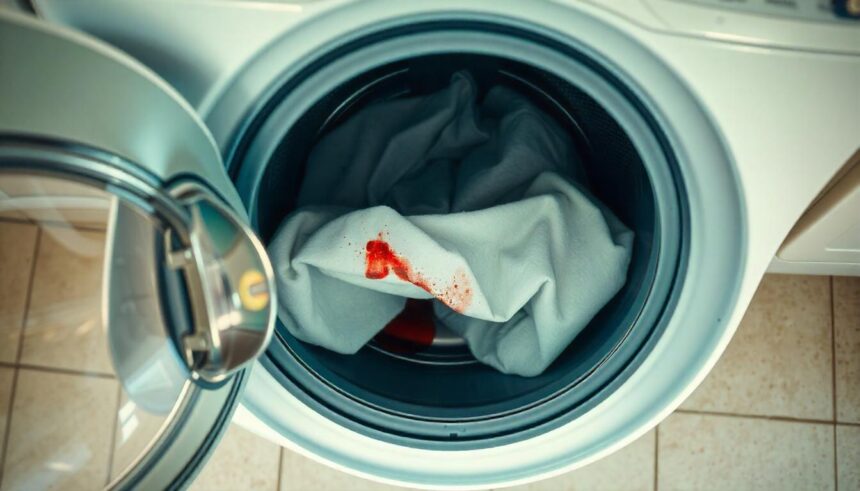We’ve all been there—enjoying a cozy night in, only to wake up to an unexpected reminder of life’s little mishaps: blood stains on your sheets. Whether it’s from a minor cut, menstrual cycle issues, or even your furry friend having an accident, blood can leave behind unsightly marks that seem impossible to remove. But fear not! Knowing how to get blood out of sheets is easier than you might think.
Addressing these stains promptly is crucial. Not only does it keep your bedding looking fresh and clean, but it also plays a significant role in maintaining hygiene in your bedroom. So roll up those sleeves because we’re about to dive into everything you need to know about tackling those pesky blood stains head-on!
Why stains happen and why it’s important to address them immediately
Stains occur for many reasons, often when we least expect them. A minor injury while cooking or an unexpected visit from Aunt Flo can turn your pristine sheets into a canvas of unsightly marks. Blood stains are particularly tricky because they contain proteins that bind to fabric fibers.
Addressing these stains immediately is essential. The longer you wait, the harder they become to remove. Fresh blood tends to lift more easily with the right techniques and products compared to dried stains, which set in over time.
Beyond aesthetics, prompt action helps maintain hygiene. Blood can harbor bacteria, posing potential health risks if left untreated. Taking care of those spots quickly not only keeps your sheets looking good but also ensures a clean sleeping environment. This simple step makes all the difference in creating a welcoming space for rest and relaxation.
The different types of blood stains and their level of difficulty to remove
Blood stains can vary significantly, influencing how challenging they are to remove.
Fresh blood stains are usually the easiest to tackle. With prompt action, cool water and a bit of soap can often do the trick.
Dried blood presents a different challenge. As it sets into fabric, it becomes more stubborn and may require stronger treatments.
Then there’s the type from periods or cuts—these can differ in composition due to various factors like medication or diet. This variation affects stain removal methods.
There are old stains that have been left for too long. These require special care and patience as they might need soaking or multiple treatments for complete removal.
Understanding these differences is essential when approaching blood stain removal effectively.
Step-by-step guide on removing fresh blood stains
Act fast when you notice fresh blood stains on your sheets. The sooner you act, the easier it will be to remove them.
First, grab cold water and gently blot the stain with a clean cloth. Avoid rubbing; this can spread the stain further.
Next, mix a solution of one tablespoon of liquid laundry detergent and two cups of cold water. Apply this mixture directly to the stain using another clean cloth or sponge. Let it sit for about 10 minutes.
Afterward, rinse thoroughly with cold water until the soap is completely gone. If any trace remains, repeat the process as necessary.
Wash your sheets in cold water according to their care label instructions. Hang them up to air dry instead of using a dryer; heat can set any remaining stains permanently.
Tips for tackling set-in blood stains
Set-in blood stains can be a real challenge. But don’t lose hope just yet.
Start by soaking the stained area in cold water for at least 30 minutes. This helps to loosen the dried blood particles, making them easier to tackle.
Next, create a paste using baking soda and water. Apply it directly onto the stain and let it sit for about 15-20 minutes before rinsing with cold water. The gentle abrasiveness of baking soda works wonders on tough spots.
If that doesn’t do the trick, consider using hydrogen peroxide on lighter fabrics. Dab a small amount onto the stain and blot gently with a cloth until you see improvement. Always test on an inconspicuous area first.
For stubborn stains, enzyme-based cleaners are your friends. They break down protein residues effectively without damaging your sheets.
DIY solutions for blood stain removal
When it comes to blood stain removal, DIY solutions can be incredibly effective. One popular method involves using cold water and salt. Mix a tablespoon of salt in a cup of cold water, then gently dab the mixture onto the stain with a clean cloth.
Another option is hydrogen peroxide. Apply it directly on the stain, allowing it to bubble for a few minutes before blotting with a damp cloth. This works wonders on fresh stains but test it first on an inconspicuous area since it can lighten some fabrics.
For those who prefer natural remedies, try baking soda paste. Combine three parts baking soda with one part water to create a thick paste. Rub this onto the stained area and let it sit for about 30 minutes before rinsing off.
These simple methods often yield impressive results without harsh chemicals or expensive products!
How to maintain your sheets to prevent future stains
Keeping your sheets fresh and stain-free starts with regular maintenance. Wash them weekly to remove dirt, oils, and potential stains before they set in.
Opt for a gentle detergent that’s effective yet kind to fabrics. Avoid harsh chemicals that can weaken fibers over time.
Consider using a fabric protector spray after washing. This creates an invisible barrier against spills and marks.
Make it a habit to check for stains right away. A quick pre-treatment with cold water can save you from tougher clean-ups later on.
Store your linens properly in a cool, dry space. Moisture can encourage mildew growth, which is just another headache you don’t need!
Conclusion: Importance of prompt action and maintaining clean sheets for hygiene purposes
Maintaining clean sheets is essential for both hygiene and comfort. Blood stains can harbor bacteria, so it’s crucial to address them promptly. Quick action not only helps in removing the stain effectively but also ensures that your sleeping environment remains healthy.
Regular washing and care of your sheets can prevent future stains from becoming a larger issue. By following the tips shared throughout this guide, you can enjoy fresh, clean bedding without worrying about unsightly marks or lingering odors. Keeping your sleep space tidy contributes to better rest and overall well-being—so don’t let those pesky stains linger!







